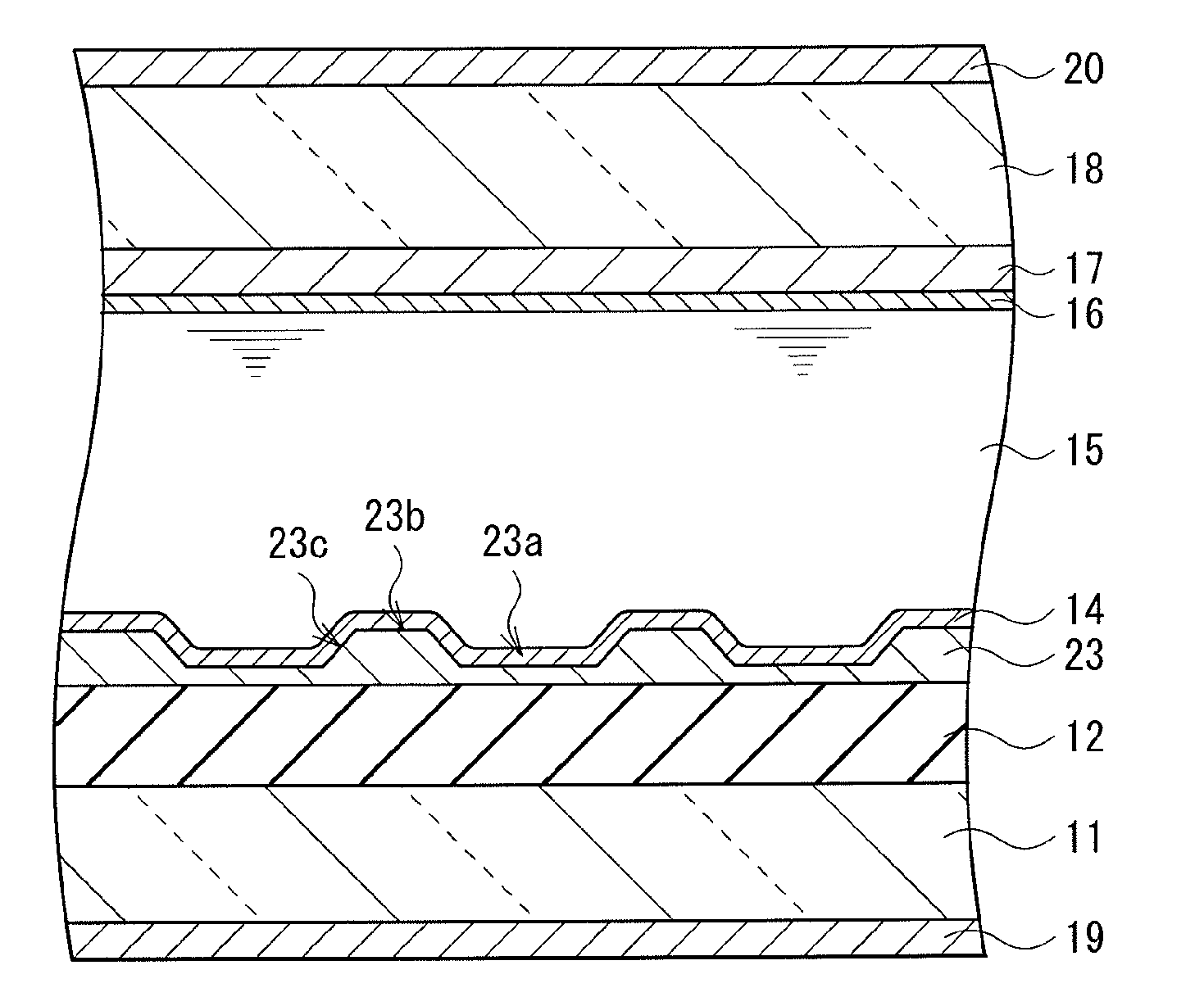Liquid crystal display and method of manufacturing liquid crystal display
a liquid crystal display and liquid crystal technology, applied in the field of liquid crystal display, can solve the problems of difficult to obtain high transmittance, difficult to align liquid crystal molecules, and difficult to achieve high transmittance, so as to achieve efficient pre-tilt, reduce the effect of transmittance suppression and high transmittan
- Summary
- Abstract
- Description
- Claims
- Application Information
AI Technical Summary
Benefits of technology
Problems solved by technology
Method used
Image
Examples
modification 1
[0121]2. Modification 1
[0122]FIG. 17 illustrates the cross-sectional structure (corresponds to part of the pixel) of the liquid crystal display panel in the liquid crystal display according to Modification 1. Like the liquid crystal display panel 2 of the above-described embodiment, in the liquid crystal display panel of this modification, the liquid crystal layer 15 is sandwiched between the drive substrate 11 and the facing substrate 18, and the polarizing plates 19 and 20 are bonded onto the outer faces of the drive substrate 11 and the facing substrate 18, respectively. A planarizing film 21 is formed on the drive substrate 11 so as to cover the surface of the drive substrate 11, and a pixel electrode 22 is disposed for each pixel 10 on the planarizing film 21. In such a structure, in this modification, the face on the liquid crystal layer 15 side of the pixel electrode 22 has the concave-convex structure, and the face on the liquid crystal layer 15 side of the opposite electrod...
modification 2
[0126]3. Modification 2
[0127]FIGS. 19A to 19C illustrates another manufacturing method of the pixel electrode 13 in the liquid crystal display according to Modification 2 in a process order. In the above-described embodiment, after the pixel electrode 13 is formed over the whole surface of the planarizing film 12, the concavo-convex structure of the pixel electrode 13 is formed by half-etching, but it is also possible to form the concavo-convex structure as will be described next. That is, as illustrated in FIG. 19A, after the planarizing film 21 is formed on the drive substrate 11, an electrode layer 130 of ITO is formed over the whole surface of the planarizing film 21 by, for example, the evaporation method or the sputtering. Next, as illustrated in FIG. 19B, the selective region (the region corresponding to the concave face 13a) of the electrode layer 130 is, for example, removed by etching using the photolithography. After this, as illustrated in FIG. 19C, an electrode layer 13...
modification 3
[0129]4. Modification 3
[0130]FIG. 20 illustrates the cross-sectional structure (corresponding to part of the pixel) of the liquid crystal display panel in the liquid crystal display according to Modification 3. Like the liquid crystal display panel 2 of the above-described embodiment, in the liquid crystal display panel of this modification, the liquid crystal layer 15 is sandwiched between the drive substrate 11 and the facing substrate 18, and the polarizing plates 19 and 20 are bonded the onto outer faces of the drive substrate 11 and the facing substrate 18, respectively. A pixel electrode 23 is disposed for each pixel 10 above the drive substrate 11 with the planarizing film 12 in between. In such a structure, also in this modification, the face on the liquid crystal layer 15 side of the pixel electrode 23 has the concave convex structure, and the face on the liquid crystal layer 15 side of the opposite electrode 17 is flat.
[0131]However, in this modification, the concavo-conve...
PUM
 Login to View More
Login to View More Abstract
Description
Claims
Application Information
 Login to View More
Login to View More - R&D
- Intellectual Property
- Life Sciences
- Materials
- Tech Scout
- Unparalleled Data Quality
- Higher Quality Content
- 60% Fewer Hallucinations
Browse by: Latest US Patents, China's latest patents, Technical Efficacy Thesaurus, Application Domain, Technology Topic, Popular Technical Reports.
© 2025 PatSnap. All rights reserved.Legal|Privacy policy|Modern Slavery Act Transparency Statement|Sitemap|About US| Contact US: help@patsnap.com



